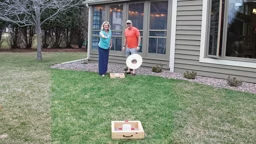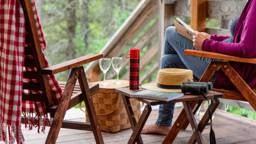Remember Hansel & Gretel? They were almost eaten when they helped themselves to the wicked witch’s gingerbread cottage.
Not to fear. Creating a gingerbread structure won’t put you in any peril here. And it’s much easier than constructing a real place.
With a bit of time, a little finesse, some basic instructions and a set of templates (these are your blueprints), a gingerbread cabin can be created in a few days.
The intent is not to lure anyone in under wicked pretenses, but rather to provide a feast for the eyes, as well as the stomach. What a great conversation piece for your holiday table – and you can proudly say, “I made it myself!”
Building basics. Before you begin, find a template to use. Templates can be found in books, on the Internet or you can (gasp!) make your own.
As you’re looking at templates, think about the style of cabin you want. Will it have flat walls made of extra, extra large “cookies,” or will it be constructed like a log cabin out of edible Lincoln Logs? You’ll also need extra-large cookies for the roof “substrate,” plus pieces for structural details such as porches, dormers and chimneys.
Templates should be cut out of a sturdy material such as cardboard or poster board. And before you go any further, it’s a good idea to do a test run: Assemble the cut-out template pieces with masking tape to make sure the cabin will fit together correctly.
Dough details. Here are the dry details on dough preparation. Pay close attention, because your cabin’s looks and stability depend on the quality of the baked walls.
Using the gingerbread dough recipe, click here for recipe, (or a dough recipe of your choice), roll out the refrigerated dough on a flat surface on baking-grade parchment paper or aluminum foil. The rolled-out dough should be approximately 1/2 inch thick and as square as possible. Roll out only enough dough for a couple of pattern pieces at a time; keep the rest of the dough refrigerated.
Lightly dust the surface of the dough with flour to prevent the pattern pieces from sticking. (But be sure to remove excess flour with a small pastry brush before baking.) Use a pizza wheel to cut out large pieces. A small paring knife is recommended for smaller pieces and intricate cuts. This is the time to cut out door and window openings if that’s part of your plan.
Peel away excess dough and save in an airtight container for landscape or cabin decorations. (Or turn it into a batch of gingerbread cookies to whet your appetite as you construct your gingerbread cabin.)
Cut the parchment paper around the pieces and transfer them, paper and all, to flat cookie sheets. (Bowed sheets will create bowed walls.) Space the pieces about an inch apart. To ensure even baking times, keep larger pieces on one sheet and smaller pieces on another.
Bake pieces in a preheated 350° oven until the dough is deep brown and crisp. Remove from oven and allow to cool for about 25 minutes before moving pieces onto a flat surface. An uneven surface may cause the pieces to crack or break. Pieces should cool a minimum of 4 hours or overnight before being assembled. You can pull the parchment paper off the pieces after they have cooled.
Not to fear. Creating a gingerbread structure won’t put you in any peril here. And it’s much easier than constructing a real place.
With a bit of time, a little finesse, some basic instructions and a set of templates (these are your blueprints), a gingerbread cabin can be created in a few days.
The intent is not to lure anyone in under wicked pretenses, but rather to provide a feast for the eyes, as well as the stomach. What a great conversation piece for your holiday table – and you can proudly say, “I made it myself!”
Building basics. Before you begin, find a template to use. Templates can be found in books, on the Internet or you can (gasp!) make your own.
As you’re looking at templates, think about the style of cabin you want. Will it have flat walls made of extra, extra large “cookies,” or will it be constructed like a log cabin out of edible Lincoln Logs? You’ll also need extra-large cookies for the roof “substrate,” plus pieces for structural details such as porches, dormers and chimneys.
Templates should be cut out of a sturdy material such as cardboard or poster board. And before you go any further, it’s a good idea to do a test run: Assemble the cut-out template pieces with masking tape to make sure the cabin will fit together correctly.
Dough details. Here are the dry details on dough preparation. Pay close attention, because your cabin’s looks and stability depend on the quality of the baked walls.
Using the gingerbread dough recipe, click here for recipe, (or a dough recipe of your choice), roll out the refrigerated dough on a flat surface on baking-grade parchment paper or aluminum foil. The rolled-out dough should be approximately 1/2 inch thick and as square as possible. Roll out only enough dough for a couple of pattern pieces at a time; keep the rest of the dough refrigerated.
Lightly dust the surface of the dough with flour to prevent the pattern pieces from sticking. (But be sure to remove excess flour with a small pastry brush before baking.) Use a pizza wheel to cut out large pieces. A small paring knife is recommended for smaller pieces and intricate cuts. This is the time to cut out door and window openings if that’s part of your plan.
Peel away excess dough and save in an airtight container for landscape or cabin decorations. (Or turn it into a batch of gingerbread cookies to whet your appetite as you construct your gingerbread cabin.)
Cut the parchment paper around the pieces and transfer them, paper and all, to flat cookie sheets. (Bowed sheets will create bowed walls.) Space the pieces about an inch apart. To ensure even baking times, keep larger pieces on one sheet and smaller pieces on another.
Bake pieces in a preheated 350° oven until the dough is deep brown and crisp. Remove from oven and allow to cool for about 25 minutes before moving pieces onto a flat surface. An uneven surface may cause the pieces to crack or break. Pieces should cool a minimum of 4 hours or overnight before being assembled. You can pull the parchment paper off the pieces after they have cooled.
Up go the walls. Before you start assembling the pieces, you will need a foundation and a bowl full of “mortar” (i.e., icing). The icing is the glue that will hold the cabin together, so you’ll need a lot.
Good choices for a foundation base are a large serving platter, cake board, or a wooden base or
1-inch-thick piece of polystyrene covered with decorative foil. Make certain the base is large enough to accommodate the cabin and any landscaping you want to include.
You will be assembling the walls first by gluing them to the base and to each other with icing, piping a liberal amount everywhere gingerbread meets gingerbread. Royal icing is the icing of choice as it keeps the pieces well cemented together. (click here for recipe link or use icing of your choice.)
Get started by marking where the cabin will sit on the base. Begin with the back wall and one side wall of gingerbread. Pipe icing along the bottom edges of the pieces and position them over the marked area. Hold the two pieces in place several seconds until the icing begins to harden. If the pieces are not fitting together evenly, gently use a serrated knife or emery board to straighten up the edges.
Now cement the front wall and other side piece in place. Pipe icing along the corners to hold the pieces together. Brace the walls with thick pretzel sticks or some other material as the icing sets. This foundation should dry a minimum of 30 minutes or overnight before you attach the roof and other pieces. After all pieces are assembled, let the cabin set overnight before you begin decorating and trimming.
Note: Some decorating may be easier to do on flat pieces of gingerbread before you assemble the cabin.
Good choices for a foundation base are a large serving platter, cake board, or a wooden base or
1-inch-thick piece of polystyrene covered with decorative foil. Make certain the base is large enough to accommodate the cabin and any landscaping you want to include.
You will be assembling the walls first by gluing them to the base and to each other with icing, piping a liberal amount everywhere gingerbread meets gingerbread. Royal icing is the icing of choice as it keeps the pieces well cemented together. (click here for recipe link or use icing of your choice.)
Get started by marking where the cabin will sit on the base. Begin with the back wall and one side wall of gingerbread. Pipe icing along the bottom edges of the pieces and position them over the marked area. Hold the two pieces in place several seconds until the icing begins to harden. If the pieces are not fitting together evenly, gently use a serrated knife or emery board to straighten up the edges.
Now cement the front wall and other side piece in place. Pipe icing along the corners to hold the pieces together. Brace the walls with thick pretzel sticks or some other material as the icing sets. This foundation should dry a minimum of 30 minutes or overnight before you attach the roof and other pieces. After all pieces are assembled, let the cabin set overnight before you begin decorating and trimming.
Note: Some decorating may be easier to do on flat pieces of gingerbread before you assemble the cabin.
All the trimmings. Now comes the fun part. Give the designer inside you full license to try anything. It’s easier than decorating your real-life cabin – and any leftover construction materials are much tastier.
Pipe swirls of icing along all the edges, seams and borders to provide a finished look and help reinforce the structure. Get different effects by using various tips – such as star tips, plain tips and leaf tips – fit over a pastry bag.
Color your icing with food coloring for different color schemes.
Let your imagination run wild when choosing candy, crackers, cereal, nuts and more to decorate the cabin and create landscaping. Here are some examples:
• Shredded wheat squares make a great thatched roof.
• Layered Necco wafer candies or wafer cookies produce a shingled roof.
• Use a wafer cookie or candy bar as a propped-open front door or for window shutters.
• Pretzels (straight or twisted) make ideal fence-building material.
• Candy rocks or jelly beans make a great “stone” foundation.
• Candy canes make tasteful porch supports or light posts.
• Nuts, coffee beans, chocolate chips, cereal, chocolate-covered raisins: These all work wonderfully to construct a chimney or walkway.
• Turn a sugar cone upside-down to form the base of an evergreen tree; cover it with green-colored royal icing.
• Suckers, lollipops and gum drops on pretzel sticks make instant trees.
• Marshmallows coated with royal icing and covered with green-colored coco-nut make realistic shrubs.
There, you have the basics. Easier than building an actual cabin, right?
If you are going to build a gingerbread cabin of your very own, detailed instructions and templates for the cabins pictured here can be found in “Making Great Gingerbread Houses” by Aaron Morgan and Paige Gilchrist. The book is available at www.bn.com, www.amazon.com and other book sellers around the country.
Until this year, Shirley Brandt has been content baking gingerbread cookies.
Pipe swirls of icing along all the edges, seams and borders to provide a finished look and help reinforce the structure. Get different effects by using various tips – such as star tips, plain tips and leaf tips – fit over a pastry bag.
Color your icing with food coloring for different color schemes.
Let your imagination run wild when choosing candy, crackers, cereal, nuts and more to decorate the cabin and create landscaping. Here are some examples:
• Shredded wheat squares make a great thatched roof.
• Layered Necco wafer candies or wafer cookies produce a shingled roof.
• Use a wafer cookie or candy bar as a propped-open front door or for window shutters.
• Pretzels (straight or twisted) make ideal fence-building material.
• Candy rocks or jelly beans make a great “stone” foundation.
• Candy canes make tasteful porch supports or light posts.
• Nuts, coffee beans, chocolate chips, cereal, chocolate-covered raisins: These all work wonderfully to construct a chimney or walkway.
• Turn a sugar cone upside-down to form the base of an evergreen tree; cover it with green-colored royal icing.
• Suckers, lollipops and gum drops on pretzel sticks make instant trees.
• Marshmallows coated with royal icing and covered with green-colored coco-nut make realistic shrubs.
There, you have the basics. Easier than building an actual cabin, right?
If you are going to build a gingerbread cabin of your very own, detailed instructions and templates for the cabins pictured here can be found in “Making Great Gingerbread Houses” by Aaron Morgan and Paige Gilchrist. The book is available at www.bn.com, www.amazon.com and other book sellers around the country.
Until this year, Shirley Brandt has been content baking gingerbread cookies.
 information, recipes and photos from “Making Great Gingerbread Houses,” Lark Books, a division of Sterling Publishing Co., Inc.
information, recipes and photos from “Making Great Gingerbread Houses,” Lark Books, a division of Sterling Publishing Co., Inc. 











